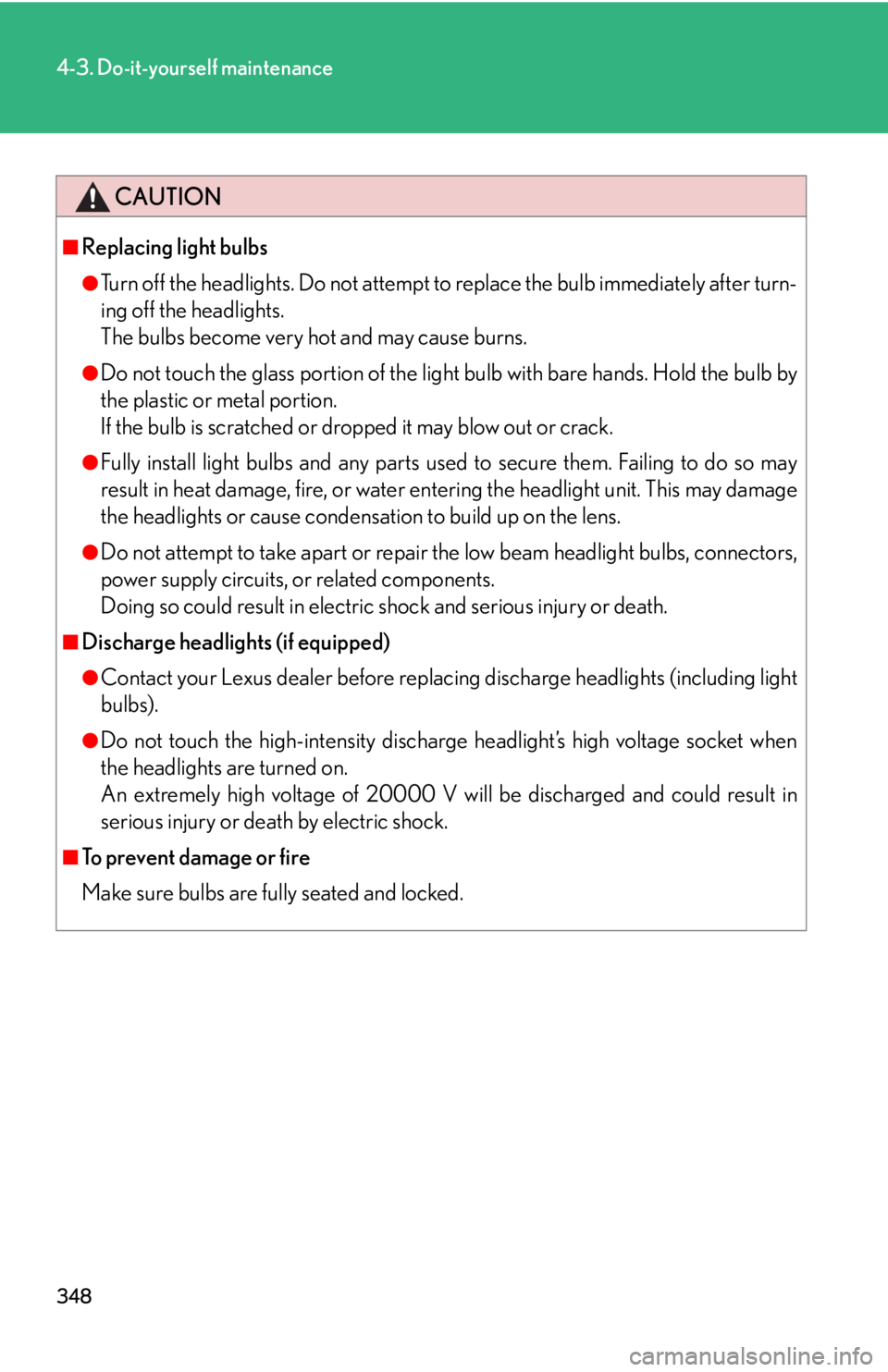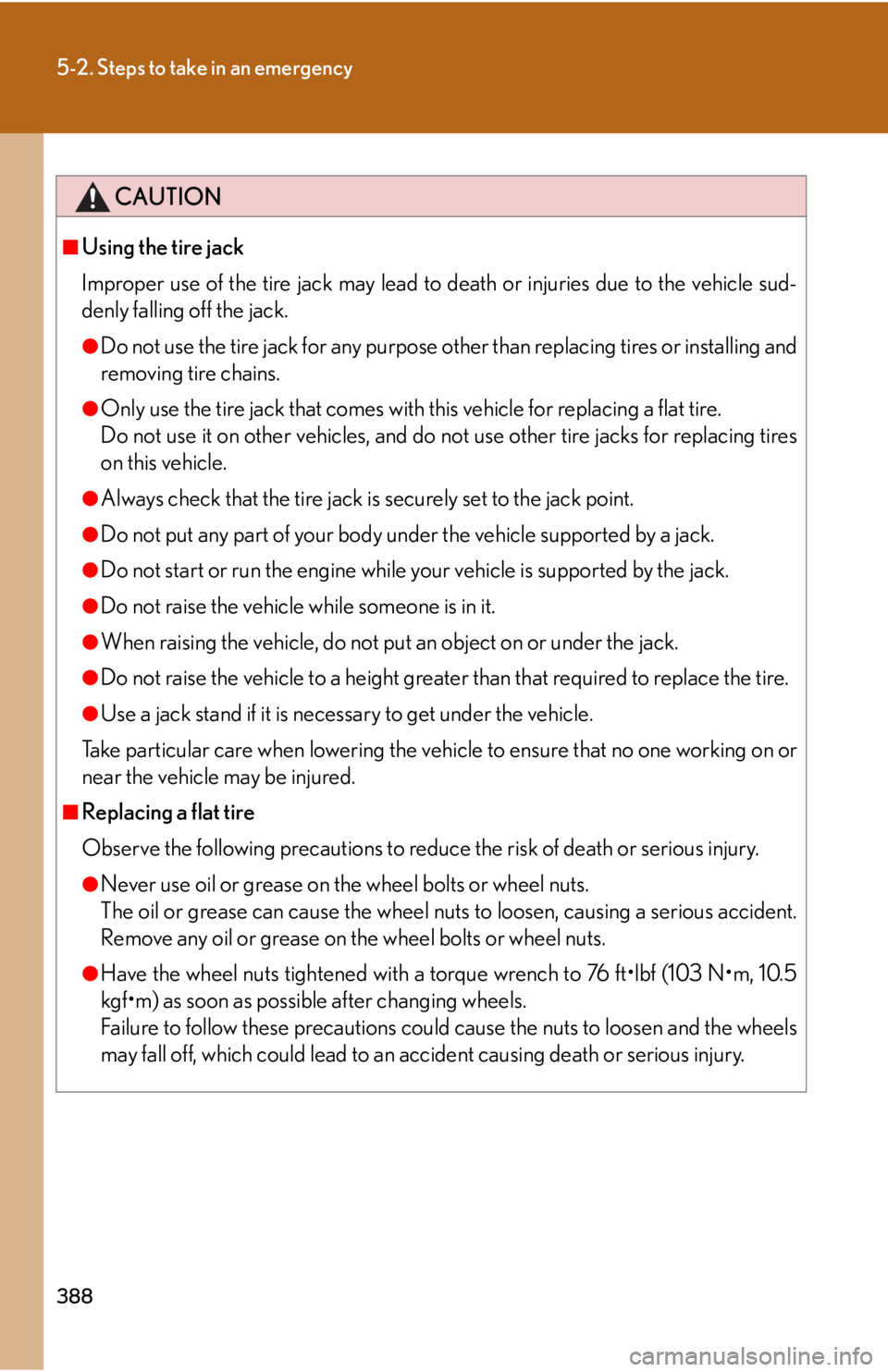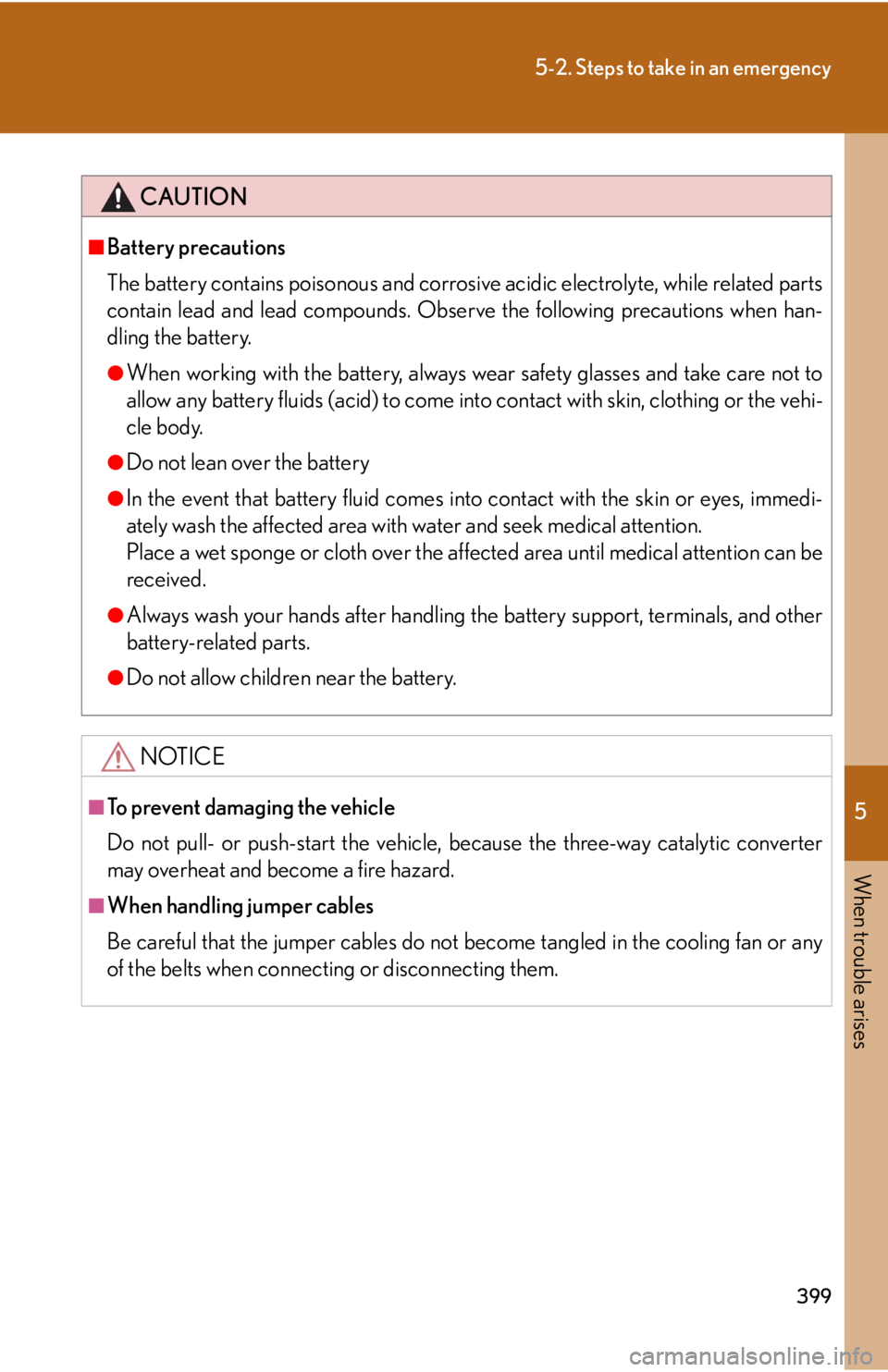Page 335 of 464
335
4-3. Do-it-yourself maintenance
4
Maintenance and care
FuseAmpereCircuit
14F/ P M P25 AFuel system
15EFI25 A
Multiport fuel injection system/
sequential multiport fuel injection sys-
tem
16INJ20 A
Multiport fuel injection system/
sequential multiport fuel injection sys-
tem
17H-LP UPR15 AHeadlight high beams
18HORN10 AHorns
19WA S H E R20 AWindshield washer
20FR TAIL10 AParking lights
21FR FOG15 AFront fog lights
Page 348 of 464

348
4-3. Do-it-yourself maintenance
CAUTION
■Replacing light bulbs
●Turn off the headlights. Do not attempt to replace the bulb immediately after turn-
ing off the headlights.
The bulbs become very hot and may cause burns.
●Do not touch the glass portion of the light bulb with bare hands. Hold the bulb by
the plastic or metal portion.
If the bulb is scratched or dropped it may blow out or crack.
●Fully install light bulbs and any parts used to secure them. Failing to do so may
result in heat damage, fire, or water en tering the headlight unit. This may damage
the headlights or cause condensation to build up on the lens.
●Do not attempt to take apart or repair the low beam headligh t bulbs, connectors,
power supply circuits, or related components.
Doing so could result in electric shock and serious injury or death.
■Discharge headlights (if equipped)
●Contact your Lexus dealer be fore replacing discharge headlights (including light
bulbs).
●Do not touch the high-intensity discharge headlight’s high voltage socket when
the headlights are turned on.
An extremely high voltage of 20000 V wi ll be discharged and could result in
serious injury or death by electric shock.
■To prevent damage or fire
Make sure bulbs are fully seated and locked.
Page 355 of 464
5
When trouble arises
355
5-1. Essential information
Using a flat bed truckIf your Lexus is transported by a
flat bed truck, it should be tied
down at the locations shown in the
illustration.
If you use chains or cables to tie
down your vehicle, the angles
shaded in black must be 45 .
Do not overly tighten the tie downs
or the vehicle may be damaged.
NOTICE
■To prevent causing serious damage to the transmission
(vehicles with an automatic transmission)
Never tow this vehicle from the front with the rear wheels on the ground.
■To prevent damaging the vehicle
●Do not tow the vehicle from the rear with the “ENGINE START STOP” switch
OFF.
The steering lock mechanism is not st rong enough to hold the front wheel
straight.
●When raising the vehicle from the rear, ensure adequate ground clearance for
towing at the opposite end of the raised vehicle. Without adequate clearance, the
vehicle could be damaged while being towed from the rear.
Page 384 of 464
384
5-2. Steps to take in an emergency
Replacing a flat tireChock the tires.
Slightly loosen the wheel nuts (one
turn).
Turn the tire jack portion “A” by
hand until the notch of the jack is in
contact with the jack point.
STEP1
Flat tireWheel chock positions
Front
Left-hand
sideBehind the
rear right-
hand side tire
Right-
hand sideBehind the
rear left-
hand side tire
Rear
Left-hand
sideIn front of the
front right-
hand side tire
Right-
hand sideIn front of the
front left-
hand side tire
STEP2
STEP3
Page 386 of 464
386
5-2. Steps to take in an emergency
Install the spare tire and loosely
tighten each nut by hand to
approximately the same amount.
Tighten the wheel nuts until the
tapered portion comes into loose
contact with the disc wheel sheet.
Lower the vehicle.
Firmly tighten each nut two or
three times in the order shown in
the illustration.
Tightening torque:
76 ft•lbf (103 N•m, 10.5 kgf•m)
Stow the flat tire, tire jack and all tools.
STEP2
Disc wheel
sheet
Tapered portion
STEP3
STEP4
STEP5
Page 388 of 464

388
5-2. Steps to take in an emergency
CAUTION
■Using the tire jack
Improper use of the tire jack may lead to death or injuries due to the vehicle sud-
denly falling off the jack.
●Do not use the tire jack for any purpose other than replacing tires or installing and
removing tire chains.
●Only use the tire jack that comes with this vehicle for replacing a flat tire.
Do not use it on other vehicles, and do not use other tire jacks for replacing tires
on this vehicle.
●Always check that the tire jack is securely set to the jack point.
●Do not put any part of your body under the vehicle supported by a jack.
●Do not start or run the engine while your vehicle is supported by the jack.
●Do not raise the vehicle while someone is in it.
●When raising the vehicle, do not put an object on or under the jack.
●Do not raise the vehicle to a height greate r than that required to replace the tire.
●Use a jack stand if it is necessary to get under the vehicle.
Take particular care when lowering the vehicle to ensure that no one working on or
near the vehicle may be injured.
■Replacing a flat tire
Observe the following precautions to reduce the risk of death or serious injury.
●Never use oil or grease on the wheel bolts or wheel nuts.
The oil or grease can cause the wheel nuts to loosen, causing a serious accident.
Remove any oil or grease on the wheel bolts or wheel nuts.
●Have the wheel nuts tightened with a torque wrench to 76 ft•lbf (103 N•m, 10.5
kgf•m) as soon as possible after changing wheels.
Failure to follow these precautions could cause the nuts to loosen and the wheels
may fall off, which could lead to an accident causing death or serious injury.
Page 399 of 464

5
When trouble arises
399
5-2. Steps to take in an emergency
CAUTION
■Battery precautions
The battery contains poisonous and corrosive acidic electrolyte, while related parts
contain lead and lead compounds. Observe the following precautions when han-
dling the battery.
●When working with the battery, always wear safety glasses and take care not to
allow any battery fluids (acid) to come into contact with skin, clothing or the vehi-
cle body.
●Do not lean over the battery
●In the event that battery fluid comes into contact with the skin or eyes, immedi-
ately wash the affected area with water and seek medical attention.
Place a wet sponge or cloth over the affected area until medical attention can be
received.
●Always wash your hands after handling the battery support, terminals, and other
battery-related parts.
●Do not allow children near the battery.
NOTICE
■To prevent damaging the vehicle
Do not pull- or push-start the vehicle, because the three-way catalytic converter
may overheat and become a fire hazard.
■When handling jumper cables
Be careful that the jumper cables do not become tangled in the cooling fan or any
of the belts when connecting or disconnecting them.
Page 410 of 464

410
6-1. Specifications
Lubrication system
*: 5W-30 is an oil that provides optimal levels of fuel efficiency.
Oil viscosity
● The 5W portion of the oil viscosity rating indicates the characteristic of
the oil which allows cold startability . Oils with a lower value before the W
allow for easier starting of the engine in cold weather.
● The 30 in 5W-30 indicates the oil viscosity when the oil is at its operating
temperature. An oil with a higher viscosity may be better suited if the
vehicle is operated at high speeds, or under extreme load condition.
IS250IS350
Oil capacity
(drain and refill)
with filter
2WD models
AWD models
6.6 qt. (6.3 L, 5.5 lmp.qt.)
6.8 qt. (6.4 L, 5.7 lmp.qt.)6.6 qt. (6.3 L, 5.5 lmp.qt.)
without filter
2WD models
AWD models
6.2 qt. (5.9 L, 5.2 lmp.qt.)
6.3 qt. (6.0 L, 5.3 lmp.qt.)6.2 qt. (5.9 L, 5.2 lmp.qt.)
Oil gradeILSAC multi-grade engine oil
Recommended oil
viscosity
Use Lexus approved “Toyota Genuine Motor Oil” or
equivalent to satisfy the grade and viscosity shown
below.
Outside temperature